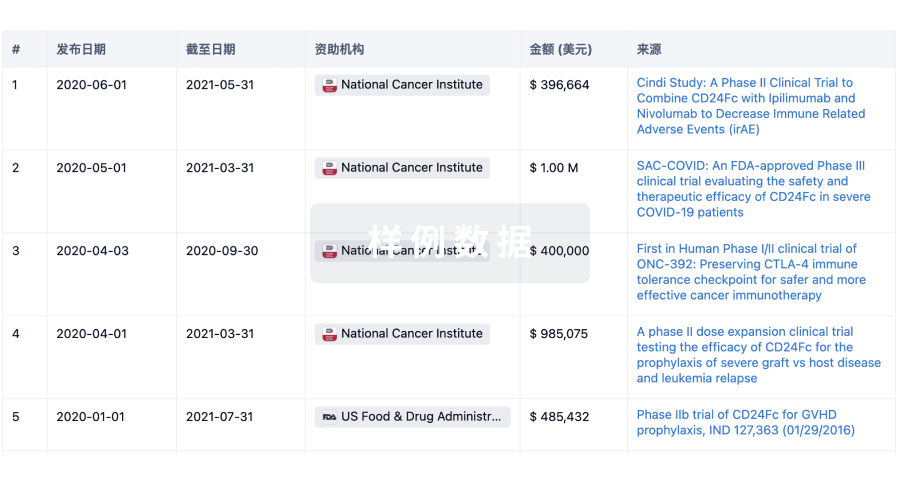预约演示
更新于:2025-05-07
Rottendorf Pharma GmbH
更新于:2025-05-07
概览
标签
皮肤和肌肉骨骼疾病
感染
小分子化药
疾病领域得分
一眼洞穿机构专注的疾病领域
暂无数据
技术平台
公司药物应用最多的技术
暂无数据
靶点
公司最常开发的靶点
暂无数据
| 疾病领域 | 数量 |
|---|---|
| 感染 | 1 |
| 排名前五的药物类型 | 数量 |
|---|---|
| 小分子化药 | 1 |
| 排名前五的靶点 | 数量 |
|---|---|
| DNA helicase/primase complex(DNA解旋酶/引物酶复合体) | 1 |
关联
3
项与 Rottendorf Pharma GmbH 相关的药物作用机制 DNA解旋酶/引物酶复合体抑制剂 |
原研机构 |
最高研发阶段临床3期 |
首次获批国家/地区- |
首次获批日期- |
靶点 |
作用机制 ASK1抑制剂 |
在研机构- |
在研适应症- |
最高研发阶段终止 |
首次获批国家/地区- |
首次获批日期- |
靶点 |
作用机制 NK2R拮抗剂 |
在研机构- |
在研适应症- |
最高研发阶段终止 |
首次获批国家/地区- |
首次获批日期- |
4
项与 Rottendorf Pharma GmbH 相关的临床试验CTR20242581
一项在携带IDH1或IDH2突变的残留或复发性2级胶质瘤亚洲受试者中开展的Vorasidenib(S095032/AG881)的III期、多中心、随机、双盲、安慰剂对照研究
本研究的目的是在携带IDH1或IDH2突变的残留或复发性2级胶质瘤亚洲受试者中评估Vorasidenib的有效性、安全性和药代动力学(PK)特征。
开始日期2024-10-18 |
申办/合作机构 |
CTR20181010
比较美金刚(Ebixa)两种制剂在健康受试者空腹和餐后的干预性、随机、单次给药、开放、交叉生物等效性研究
-主要目的:确定10mg美金刚无乳糖片和已上市的10mg美金刚含乳糖片(Ebixa®)在空腹和餐后条件下单次服用时的生物等效性。-次要目的:评价在空腹和餐后状态下服用美金刚无乳糖和含乳糖片后的特定次要药代动力学(PK)参数(例如,tmax)。-安全性目的:评价两种药物制剂的安全性和耐受性
开始日期2018-08-28 |
申办/合作机构  H. Lundbeck A/S H. Lundbeck A/S [+2] |
CTR20150472
在AD和MMSE评分5–18患者中评价每日一次与每日两次美金刚治疗的安全性与耐受性的干预性、随机、双盲研究
主要目的:
- 在阿尔茨海默型痴呆和MMSE评分5–18的患者中评价20mg每日一次盐酸美金刚片给药方案与10mg每天两次相比的安全性与耐受性。
次要目的:
- 从临床总体印象来评价盐酸美金刚片每天一次(OD)相比每天两次(B.I.D.)的疗效。
开始日期2015-10-23 |
申办/合作机构  灵北(北京)医药信息咨询有限公司 灵北(北京)医药信息咨询有限公司 [+2] |
100 项与 Rottendorf Pharma GmbH 相关的临床结果
登录后查看更多信息
0 项与 Rottendorf Pharma GmbH 相关的专利(医药)
登录后查看更多信息
6
项与 Rottendorf Pharma GmbH 相关的文献(医药)2020-08-01·Applied Microbiology and Biotechnology3区 · 工程技术
Flavin-dependent N-hydroxylating enzymes: distribution and application
3区 · 工程技术
Review
作者: Tischler, Dirk ; Mügge, Carolin ; Heine, Thomas ; van Berkel, Willem J H ; Paul, Caroline E ; Baraibar, Alvaro Gomez
2019-01-01·European Journal of Pharmaceutics and Biopharmaceutics2区 · 医学
Conversion of PLGA nanoparticle suspensions into solid dosage forms via fluid bed granulation and tableting
2区 · 医学
Article
作者: Horster, Lutz ; Kiehm, Kevin ; Bernhardt, Alexander ; Langer, Klaus
2009-11-01·Drug Development and Industrial Pharmacy4区 · 医学
Use of crospovidone as pelletization aid as alternative to microcrystalline cellulose: effects on pellet properties
4区 · 医学
Article
作者: P. Kleinebudde ; K.-J. Steffens ; P. Verheyen
100 项与 Rottendorf Pharma GmbH 相关的药物交易
登录后查看更多信息
100 项与 Rottendorf Pharma GmbH 相关的转化医学
登录后查看更多信息
组织架构
使用我们的机构树数据加速您的研究。
登录
或

管线布局
2025年10月02日管线快照
管线布局中药物为当前组织机构及其子机构作为药物机构进行统计,早期临床1期并入临床1期,临床1/2期并入临床2期,临床2/3期并入临床3期
临床3期
1
2
其他
登录后查看更多信息
当前项目
| 药物(靶点) | 适应症 | 全球最高研发状态 |
|---|---|---|
Pritelivir ( DNA helicase/primase complex ) | 单纯疱疹 更多 | 临床3期 |
艾波度坦 ( NK2R ) | 肠易激综合征 更多 | 终止 |
Selonsertib ( ASK1 ) | 非酒精性脂肪性肝炎 更多 | 无进展 |
登录后查看更多信息
药物交易
使用我们的药物交易数据加速您的研究。
登录
或

转化医学
使用我们的转化医学数据加速您的研究。
登录
或

营收
使用 Synapse 探索超过 36 万个组织的财务状况。
登录
或

科研基金(NIH)
访问超过 200 万项资助和基金信息,以提升您的研究之旅。
登录
或

投资
深入了解从初创企业到成熟企业的最新公司投资动态。
登录
或

融资
发掘融资趋势以验证和推进您的投资机会。
登录
或

Eureka LS:
全新生物医药AI Agent 覆盖科研全链路,让突破性发现快人一步
立即开始免费试用!
智慧芽新药情报库是智慧芽专为生命科学人士构建的基于AI的创新药情报平台,助您全方位提升您的研发与决策效率。
立即开始数据试用!
智慧芽新药库数据也通过智慧芽数据服务平台,以API或者数据包形式对外开放,助您更加充分利用智慧芽新药情报信息。
生物序列数据库
生物药研发创新
免费使用
化学结构数据库
小分子化药研发创新
免费使用


